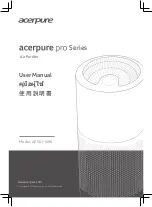
4 Installation
Installation manual
9
RRGA04~08DAV3
ROTEX HPSU Bi-Bloc Ultra
4P496756-1B – 2018.07
4.3.1
To connect the refrigerant piping to the
outdoor unit
1
Connect the liquid refrigerant connection from the indoor unit to
the liquid stop valve of the outdoor unit.
1×
a
b
c
a
Liquid stop valve
b
Gas stop valve
c
Service port
2
Connect the gas refrigerant connection from the indoor unit to
the gas stop valve of the outdoor unit.
NOTICE
It is recommended that the refrigerant piping between
indoor and outdoor unit is installed in a ducting or the
refrigerant piping is wrapped with finishing tape.
4.4
Checking the refrigerant piping
4.4.1
To check for leaks
NOTICE
Do NOT exceed the unit's maximum working pressure (see
"PS High" on the unit name plate).
NOTICE
Make sure to use a recommended bubble test solution
from your wholesaler. Do not use soap water, which may
cause cracking of flare nuts (soap water may contain salt,
which absorbs moisture that will freeze when the piping
gets cold), and/or lead to corrosion of flared joints (soap
water may contain ammonia which causes a corrosive
effect between the brass flare nut and the copper flare).
1
Charge the system with nitrogen gas up to a gauge pressure of
at least 200 kPa (2 bar). It is recommended to pressurize to
3000 kPa (30 bar) in order to detect small leaks.
2
Check for leaks by applying the bubble test solution to all
connections.
3
Discharge all nitrogen gas.
4.4.2
To perform vacuum drying
1
Vacuum the system until the pressure on the manifold indicates
−0.1 MPa (−1 bar).
2
Leave as is for 4-5 minutes and check the pressure:
If the pressure…
Then…
Does not change
There is no moisture in the
system. This procedure is
finished.
Increases
There is moisture in the
system. Go to the next step.
3
Vacuum the system for at least 2 hours to a manifold pressure
of −0.1 MPa (−1 bar).
4
After turning the pump OFF, check the pressure for at least
1 hour.
5
If you do NOT reach the target vacuum or CANNOT maintain
the vacuum for 1 hour, do the following:
▪ Check for leaks again.
▪ Perform vacuum drying again.
NOTICE
Make sure to open the stop valves after installing the
refrigerant piping and performing vacuum drying. Running
the system with the stop valves closed may break the
compressor.
4.5
Charging refrigerant
4.5.1
To determine the additional refrigerant
amount
WARNING
If the total refrigerant charge in the system is ≥1.84 kg
(i.e. if the piping length is ≥27 m)
, you need to comply
with additional minimum floor area requirements for the
indoor unit. For more information, see the indoor unit
installation manual.
If the total liquid
piping length is…
Then…
≤10 m
Do NOT add additional refrigerant.
>10 m
R=(total length (m) of liquid
piping–10 m)×0.020
R=Additional charge (kg) (rounded in units
of 0.1 kg)
INFORMATION
Piping length is the one-way length of liquid piping.
4.5.2
To charge additional refrigerant
WARNING
▪ Only use R32 as refrigerant. Other substances may
cause explosions and accidents.
▪ R32 contains fluorinated greenhouse gases. Its global
warming potential (GWP) value is 675. Do NOT vent
these gases into the atmosphere.
▪ When charging refrigerant, ALWAYS use protective
gloves and safety glasses.
Prerequisite:
Before charging refrigerant, make sure the refrigerant
piping is connected and checked (leak test and vacuum drying).
1
Connect the refrigerant cylinder to the service port.
2
Charge the additional refrigerant amount.
3
Open the gas stop valve.


































